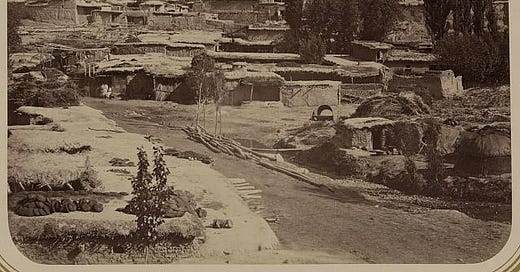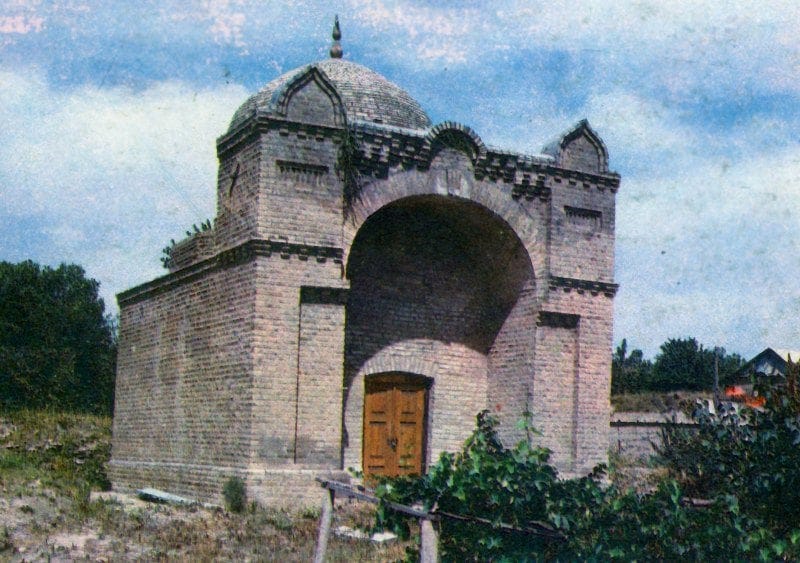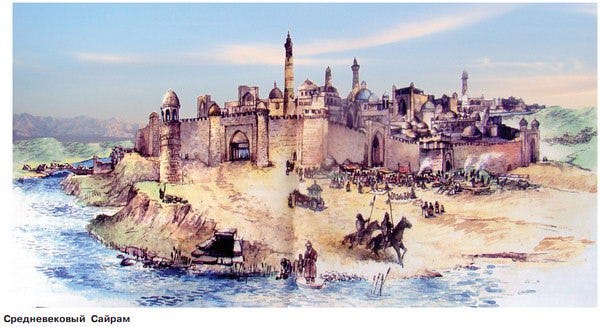Sayram Antiquities - Alexander Geins, 1898
Translation on the historic landmarks of Sayram in southern Kazakhstan
Preliminary note: For Gmail readers, this essay might be clipped due to size limitations. To read the entire essay simply click on “View entire message” at the bottom of the email, thanks.
Translator’s Introduction
Below is a translation about the historic landmarks in the city of Sayram,which is located in modern day southern Kazakhstan, just east of Shymkent. This is an excerpt from Alexander Geins’ “Notebook of 1866". Travel in Turkestan.” I have translated several other excerpts from Geins’ works which can be also found on this blog.
One thing in particular which I like would like draw attention to is the local’s claim that the “son of Adam” built objects in the city. Not only is this interesting in terms of how memory of the past and of how things came to be would often be lost, as Geins’ notes himself, this phenomenon also has clear parallels elsewhere. Historically in the Caucasus the construction of ancient sites were attributed to Alexander the Great, while elsewhere in Central Asia Tamerlane was often given credit. Alikhanov-Avarksy in “The Expedition to Khiva” mentions this. It’s interesting how a generic historical figure comes to be thought of as “the builder” in the popular consciousness of the population.
The source for this translation can be found here. The original text can be found here.
Lastly, footnote 8 refers to Khoja Ahmed Yasawi. His mausoleum is located in the city of Turkestan, located northeast of Shymkent and Sayram. The building is quite beautiful, built in the Timurid style with blue tiles, I posted modern and historic photos of it recently on Twitter/X.
Sayram Antiquities
The entrance to this city is the same as all local towns. First, there is arable land that is not fenced, but further ahead there are low clay walls for aryks1 that stretch along both sides of the road, due to trees growing nearby.2 Further along the valley of the Sayram-Su River are auls3 of Kyrgyz4 that are picturesque amidst the herds scattered about the slopes of the valley. With each step forward gardens become thicker; aryks are encountered more and more often, their water is more abundant, and as a result the road becomes harder for arbas5 and you start to tossed around in your tarantas6 which threatened us every minute to throw us into an aryk. In the end, the road ran into a building whose walls lack any windows - we had entered the city.
The aksakal7 and other honorable individuals from the city met us earlier, ahead the city’s gardens, and rode with us until we reached our quarters, which Chaikovsky, who was travelling with us, had already taken care of. Resting a little, we got on our horses and went around the city. Its external appearance resembles all other Middle Asian cities, with only some slight differences.
Sayram is known for its large number of saints, which of course, number among the descendants of Muhammad. The graves of Ibrahim-Khoja, the father of the Turkestan Azret,8 and the mother of the latter are particularly revered here. Monuments made from cooked bricks have been built on top of these graces, similar to those that we encountered at Fort Perovsk.9 There is also a very old monument over the site where Khazyr was saved, some particularly respected saint. Muslims say that we honor him and that he was taken to heaven while still alive, but in response to our questions of whether he is Enoch or Methuselah, they answered with “dzhok.”10
I went down into the cave of Khazyr. At first it goes down along straight set of stairs, but further there is a difficult spiral staircase which leads to a narrow clay hole, through which one must climb though legs first. In such a manner you will make it into a cave only a few steps wide in width. Mats have been laid out on the floor for pious pilgrims to pray. Here, Khazyr was saved while in contemplation of the greatness of Allah, having not seen the light of God for sixteen years and then having lived for a few years more, he was taken up to heaven alive. Above the cave now stands a half ruined mosque made from baked bricks with some ceramic glaze still remaining on its surface. It was once very beautiful.
We went to the madrasa which was very large, with an unkempt sarai,11 a pond and hundred year old mullberry trees standing in front. One them was so thick that three people could wrap around it. Inside, the ceiling of the madrasa is supported by several wooden columns, among which our attention stopped at a very ancient column of solid sandstone. Its appearance reminded me of the small columns in our ancient churches which begin thickening in their middle area. Some sort of cuneiform letters can be seen at the head of the columns. G. and P. found that these are old Slavonic letter, and to my question of how they ended up here, they answered that the column might have bee built during the time of the Tatar pogrom. For clarification regarding this question, we turned to the dignitaries of Sayram who surrounded us.
“This was made by one of the sons of Adam and it was not brought here from anywhere, it has always stood here,” they answered.
Although this column was not built by the son of Adam, that response however reminded me that everything here is very old and information has long been lost to time, and thus many things are attributed to Adam. This is a sign that life is very old in this place.
We then passed by the bazar that was very large and neatly laid out, and past one caravan-sarai which had only just been rebuilt by one of Saryam’s merchants; after this we returned home, where Chaikovsky’s table was awaiting us.
Sayram is occupied by a detachment that was sent by Chernyaev that is under the command of the artillery captain Abramov. Approaching here, Abramov demanded the city surrender, but the Kyrgyz-dzhigit12 who transmitted this demand, was admitted into the city and the doors slammed shut behind him. The enraged Sarts13 rushed at him and killed him. After waiting a bit, Abramov opened fire on the city and prepared to storm it, but the Sarts surrendered.
(….)
By evening we headed back. The full moon rose above the snowy mountains that enclose Sayram to the east. The fresh evening air was completely transparent and showed all of the details of the alpine landscape, with green gardens below, which drowned out the buildings of Sayram. The view was extremely beautiful.
Small irrigation ditches that a common across Central Asia.
Aryks were often dug under trees since their shade would protect the water from evaporation.
Nomadic villages, made up of yurts.
Actually Kazakhs. The modern Kazakhs were usually called Kyrgyz prior to the Soviet era.
A type of two wheeled cart.
A four wheeled horse cart.
“White beard.” A term meaning elder.
Azret is the nickname for the 12th century Sufi poet Ahmad Yasawi.
Modern day Kyzylorda.
Kazakh for “no.”
A hotel of sorts for caravans.
In other words, a Kazakh rider.
General term for the sedentary population of Central Asia.







